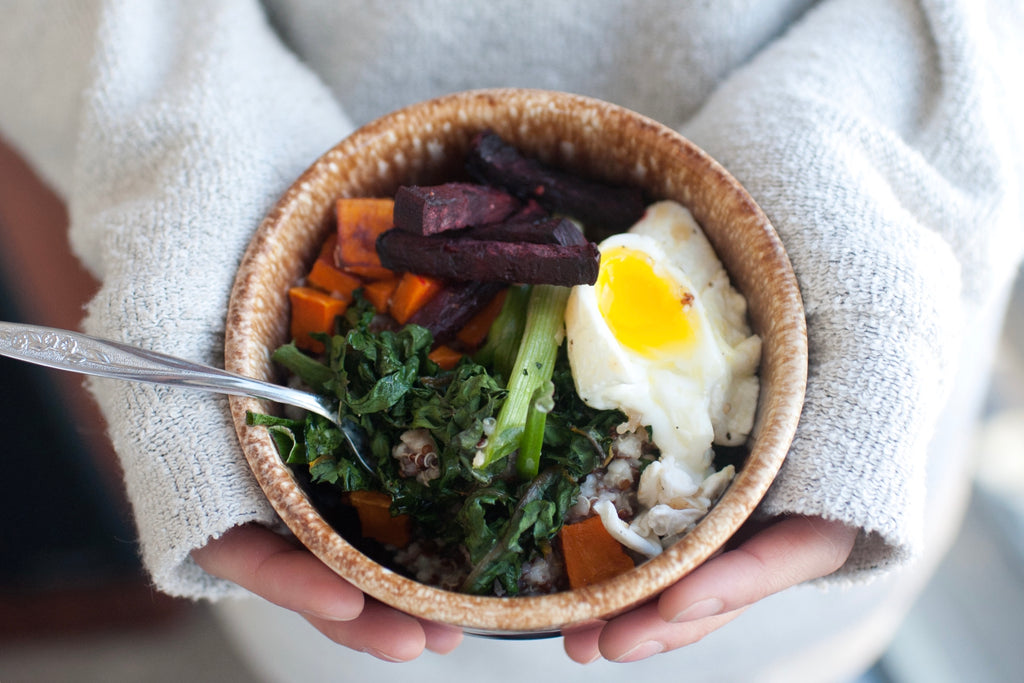For many women, abdominal pain is a monthly event, and one for which there seems to be no respite. It turns out that there are many clinical strategies, as well as home medicines, in Chinese medicine that can help significantly reduce menstrual cramping. This week’s recipe builds on some of those basic principals. One of the most common causes of menstrual cramping, according to Chinese medicine, is “cold” – both the physical cold of the environment and foods that have the property of being “cold.” To combat this problem, we have created a savory porridge flavored with “pungent, warming” spices that are commonly used in the treatment of menstrual cramps.

We begin with a blend of quinoa and oats. Like all grains, they are “sweet” and supplement the Spleen and Stomach. When cooked with extra water and made into porridge, they make the ideal vehicle for delivering the warming spices that can help alleviate menstrual cramping. There is actually a long history of using congee or porridge in Chinese medicine for medicinal purposes. The physical warmth of the porridge accents the properties of the spices themselves.
The next key element of this porridge is the spices. Ginger is well known in Chinese medicine for bringing warmth to the center of the body. Cinnamon is actually even more warming than ginger. It travels to the most interior “Blood” level, making it a powerful medicinal for moving the blood, dispersing cold, and relieving menstrual pain. Both ginger and cinnamon are also consider “pungent,” which gives them the property of dispersing obstructions and stagnations that may contribute to pain.
To round out this porridge, we have incorporated a selection of vegetables and one protein source. Rainbow chard and butternut squash are both “cooling” vegetables, but the warmth of the porridge ameliorates these properties. Beets and dates are both “sweet” and supplement the blood, and therefore help with menstrual irregularities.


Lastly, we have added a poached egg to this dish. Eggs have long been recognized in Chinese medicine for their nourishing properties, particularly for “supplementing blood.” They have many folk uses for pregnancy and post-partum recovery and are the ideal protein to complete this dish.

In clinical practice, it is common to begin treating a woman for menstrual cramps one week prior to the beginning of her period. You can use this porridge in a similar fashion, consuming it regularly before or during menstruation to help reduce abdominal pain.

Roasted Squash Porridge with Beets, Chard and Browned Butter
Serving size
About 2
Prep Time / Cook Time
15 minutes / around 30 minutes
Ingredients
1 Cup Quinoa
1 Cup Oats
Veg Stock as needed
1/8-1/4 cup Almond Milk or to taste
1-2 Inches Ginger
3-4 Dates
Couple Dashes Cinnamon
¼ -1/2 Cup Butternut Squash
¼ -1/2 Rainbow Chard
¼ -1/2 Beets
2-4 Scallion
1-2 Egg
Splash Vinega
½-3/4 Cup Butter
Salt and Pepper
Directions
Cook the quinoa in the vegetable stock, adjust seasoning and set aside.
Cook the oats in vegetable stock and a little almond milk with a couple dashes of cinnamon an inch or two of fresh chopped or grated ginger and a few chopped dates and set aside.
Mix the cooked quinoa with the cooked oats in any ratio you like, we would recommend a 50/50 ratio to start but feel free to adjust to personal taste and add more stock or almond milk or both as necessary to get the desired texture, thicker or thinner depending on your mood.
Prep the vegetables by chopping the chard, dicing the squash and beets. Toss each with a bit of olive oil and salt and pepper and place on a roasting pan or baking sheet along with a couple scallions and roast in a 400 degree oven until each is cooked to desired doneness. The chard and scallion will be ready sooner while the squash and beets will take longer. Set aside.
Make a little brown butter by browning a little unsalted butter in a small sauce pan simply by placing the butter on medium heat until it begins to brown and take on a nutty flavor. Skim the top and pour off the nice brown butter while leaving the dark bits in the pan. Once the butter begins to brown it can begin to burn quickly so be ready to get it out of the hot pan.
Poach the egg or eggs in simmering water with a splash of distilled or white wine vinegar, stirring the water to begin the water moving in a circular motion just before adding the eggs. Crack the eggs individually into a cup or cups and add one at a time to the slightly swirling and acidulated water. Cook approximately four to five minutes for a soft to medium soft poached egg and remove with a slotted spoon.
Build or assemble your porridge, congee or bowl as you like, typically beginning with the quinoa/oat mixture then adding the vegetables and the poached egg and finishing with the browned butter and perhaps a bit of fresh cracked black pepper.
A porridge such as this is just an example and you should feel free to experiment with any mix of proteins, vegetables, fruit, nuts, seeds or other. Things like kimchi and seaweed are great ingredients to use so be creative and have fun!
















